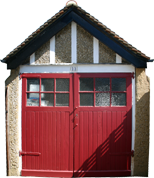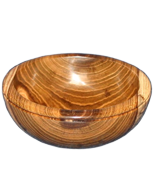Woodturning Projects.
Making Belaying Pins
This project came about because I used to own a small sailing
boat called a Drascombe Lugger which has two
wooden masts and carries three sails. The traditional
gaff rig of the boat includes a method of attaching the
haliards (the ropes holding the sails up) by making
them fast (attaching them), to specially shaped pegs of
wood. These pegs of wood are named Belaying
Pins, and they have been used to secure ropes on
traditional sailing boats for hundreds of years.
Sailing my Drascombe Lugger on Loch Ken, Scotland,
5th May 2008.
A fellow Lugger sailor at my sailing club mentioned
that he had broken his belaying pins - and, having recently purchased a lathe, in a rash
moment - I promised to make him two new ones! So what
follows is an account of how the pins were made -
starting with a log of Ash - and ending with the
two completed pins.
Belaying Pins in Use
![[Belaying pins in use - click for full size picture] Belaying pins in use](images/img_5791crthmb.jpg)
|
Belaying Pins in Use On My Drascombe Lugger.
Here is a photograph of the wooden main mast
supported by the Teak mast thwart with the two Ash
belaying pins inserted into their respective holes
in the thwart, one each side of the mast. The right
(starboard) pin is used to secure the mainsail haliard
(white rope), whilst the left
(port) pin is used for tying off the mainsail
downhaul (white coloured rope with flecks of green).
(Click on image for larger view)
|
What are the pins made of?
The pins have to securely hold the ropes attached to
them, and need to be made out of a strong, tough and
resiliant hardwood which will not easily mark when the
rope (under tension), wraps around them. European
Ash (Fraxinus excelsior) has just the right
properties and is traditionally the wood of choice for
belaying pins.
Step by Step Guide
Ash can be purchased from a timber merchant, or else
another source is an Ash log from a firewood supplier or
tree surgeon. If freshly cut, the wood must be seasoned
before it it can be worked.
![[Ash log before cutting - click for full size picture] Ash log before cutting](images/img_2523crscthmb.jpg)
|
The
Ash Log before cutting
This photograph shows the log of Ash before it was
cut into blanks for turning on the lathe. There is
enough wood for about 6 pins in this log.
(Click on image for larger view)
|
![[Cutting the log on a bandsaw - click for full size picture] Cutting the log on a bandsaw](images/img_2562crscthmb.jpg)
|
Cutting the log on a bandsaw
Here the log is on the cutting table of a bandsaw
which can be used as a 'sawmill' to accurately cut
the log into rectangular strips with a 30 mm square
profile.
(Click on image for larger view)
|
![[End result of the sawing - click for full size picture] End result of the sawing](images/img_2572adcrscthmb.jpg)
|
End result of the sawing
This photograph shows the end result of the bandsaw
cutting. The six blanks of Ash are ready to be
turned on the lathe to make six belaying pins. Each
blank measures 253 mm long by 30 mm square
(Click on image for larger view)
|
Making a Pattern Stick
Before the wood was turned on the lathe, a full-scale
drawing showing the dimensions of the belaying pin
was made and printed out. This was then glued on some
thin ply to make, what turners call, a Pattern
or Sizing Stick. If anyone wood like to make a belaying pin, a full-scale drawing of the
belaying pin has been reproduced as an Adobe Acrobat
Reader pdf document (see below).
![[Belaying pin full-scale drawing - click for full size pdf version] Belaying pin full-scale drawing](images/belaying-pin-marking-stick-rotthmb.gif)
|
The Belaying pin
full-scale drawing
On the left is a thumbnail photograph which links
to a full-size drawing of the belaying pin in pdf
format. You will need the free Adobe Acrobat Reader
software to view & accurately print out this
drawing. To make your own pattern stick you need to
print the drawing at full-scale.
After printing, check with a ruler that the
coloured dimension lines on the printout are full
scale. The drawing can then be trimmed and glued to
stiff card or thin plywood ready for use with the
lathe.
(Click on image for pdf view)
|
Using the Lathe to Make the Pins.
The next
stage is to use the lathe to turn the rectangular pieces
of wood into finished belaying pins.
![[Ash blank mounted on the lathe - click for full size picture] Ash blank mounted on the lathe](images/img_2619crscthmb.jpg)
|
Ash blank mounted on the lathe
This photograph shows one of the rectangular pieces
of Ash which were cut from the log using the
bandsaw, mounted on the lathe - ready to turn.
(Click on image for larger view)
|
![[Turning a cylinder - click for full size picture] Turning a cylinder](images/img_2620crscthmb.jpg)
|
Turning a cylinder
Once the wood has been securely mounted, the lathe
is switched on and a the Roughing Out Gouge
is used to progressively remove the edges of the
wood to convert it from a square-edged plank to a
near perfect cylinder. The picture shows work in
progress with the wood almost cylindrical at the
right hand side of the lathe, but still square in
section to the left.
(Click on image for larger view)
|
![[Marking out the pin dimensions - click for full size picture] Marking out the pin dimensions](images/img_2621scthmb.jpg)
|
Marking
out the pin dimensions.
With the conversion to a cylinder completed, it is
time to lay the full-scale drawing on the Pattern
Stick next to the wood (supported by the lathe tool
rest) and transfer the dimensions from the drawing,
by means of a pencil, to the rotating wood.
(Click on image for larger view)
|
![[Making sizing cuts - click for full size picture] Making sizing cuts](images/img_2624crscthmb.jpg)
|
Making sizing cuts with a Parting Tool
The next stage is to use a chisel called a
Parting Tool to make the initial sizing
cuts. The chisel is deployed in one hand whilst
callipers set to the correct dimension are pressed
gently against the wood from the other direction.
The cut is continued until the callipers can be
pushed gently across indicating that the cut has
been made to the correct diameter. Note that for
the purpose of photography the lathe has been
stopped.
(Click on image for larger view)
|
![[Cutting the pin shaft - click for full size picture] Cutting the pin shaft](images/img_2625crscthmb.jpg)
|
Cutting the pin shaft
In this photograph the Roughing Out Gouge is
being used again to shape the shaft of the pin. The
un-shaped head of the pin is shown on the right. A skew chisel can be used to plane the shaft to a flat finish.
(Click on image for larger view)
|
![[Shaping the pin head - click for full size picture] Shaping the pin head](images/img_2627crscthmb.jpg)
|
Shaping the pin head
Here the Spindle Gouge is being used to
shape the head of the belaying pin.
(Click on image for larger view)
|
![[Using a cheesewire to burn a decoration - click for full size picture] Using a cheesewire to burn a decoration](images/img_2664crscthmb.jpg)
|
Using a cheesewire to burn a decoration
A cheesewire is a handy way of burning a
black decorative band on the handle of the pin. The
point of a skew chisel is used to cut a
groove where the decoration will be. The speed of
the lathe is then increased and the wire held
within the groove. The friction causes the wire to
become so hot that it scorches a neat line in the
groove.
(Click on image for larger view)
|
![[Removing the completed pin from the lathe - click for full size picture] Removing the completed pin from the lathe](images/img_2632rotcrscthmb.jpg)
|
Removing the completed pin from the lathe
After the turning has been completed, the whole pin
is sanded smooth by holding abrasive paper against
the wood whilst it is rotating in the lathe. The
pin is then ready for removal from the lathe. The
waste wood at each end of the pin is thinned down
(but not cut through completely) using the parting
tool. The lathe is then stopped and a small saw is
used to cut the pin from the waste wood at each
end. The ends can then be sanded smooth to blend in
with the rest of the pin.
(Click on image for larger view)
|
![[Checking dimensions with the pattern stick - click for full size picture] Checking dimensions with the pattern stick](images/img_2636adcrscthmb.jpg)
|
Checking the dimensions
The completed pin is shown next to the pattern
stick which is used as a check that the overall
dimensions are correct.
(Click on image for larger view)
|
![[Two completed belaying pins - click for full size picture] Two completed belaying pins](images/img_2673adcrscthmb.jpg)
|
Two completed belaying pins
Two completed belaying pins, ready for use.
(Click on image for larger view)
|
Project started September 2009 and completed October
2009
Click HERE to return to the Home
Page.
© Tim & Trish Enterprises 2015-2017.


![[Photograph of my Drascombe Lugger sailing on Loch Ken, Scotland] Photograph of my Drascombe Lugger sailing on Loch Ken, Scotland.](images/drascombe-lugger.jpg)